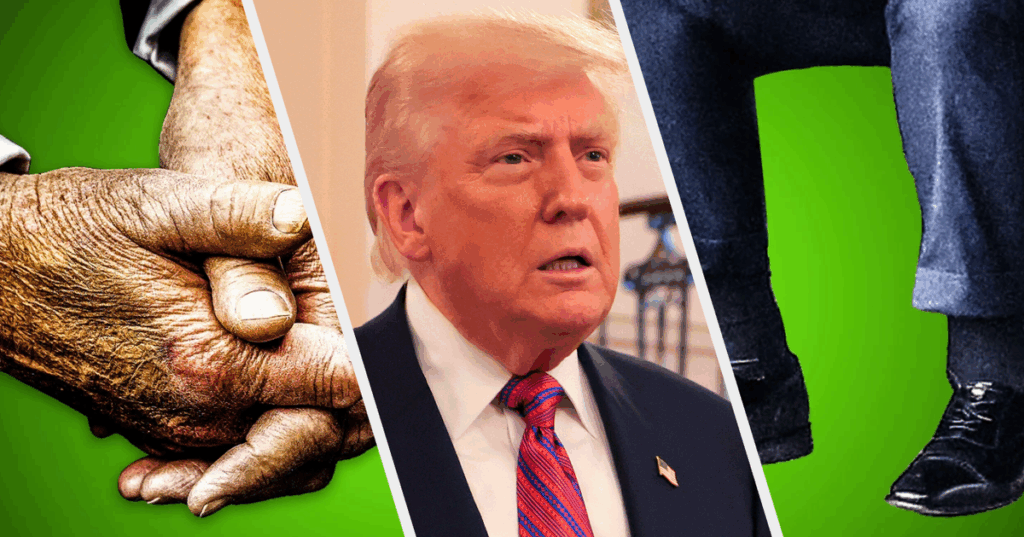🔴 Website 👉 https://u-s-news.com/
Telegram 👉 https://t.me/usnewscom_channel
This week, the White House answered two questions many people have been asking: Why are Donald Trump’s legs and ankles swollen? And why is there a bruise on his hand that’s often covered by makeup?
The answer? First, the leg swelling is due to chronic venous insufficiency, which White House press secretary Karoline Leavitt described as a “benign and common condition.”
The bruise on his hand is unrelated and due to hand shaking and the use of aspirin, the White House said in a memo.
“It’s very rare for people to get chronic venous insufficiency in the arms, and so it’s unlikely that the skin discoloration is due to varicose vein[s] or the chronic venous insufficiency issue,” said Dr. Hugh Pabarue, a physician and vein specialist at Metro Vein Centers in Michigan.
As we age, our skin thins and blood vessels become more easily exposed, so an accidental hand bump against the table can lead to easier bruising, Pabarue noted. But, once again, that isn’t the same thing as chronic venous insufficiency.
Doctors say there are a few things you should know about chronic venous insufficiency in addition to Trump’s visible leg-swelling issue. Here’s what to know:
Blood flow issues are at the center of chronic venous insufficiency.
Dr. Alexa Mieses Malchuk, a family physician in North Carolina, said chronic venous insufficiency is common, especially as folks age.
To understand what chronic venous insufficiency is, it’s important to understand how arteries and veins work, said Mieses Malchuk.
“And there’s one big, important difference between them, and that’s that arteries will actively pump blood around the body,” she said.
“Veins, on the other hand, do not pump blood, which surprises a lot of people because many people know that the veins do carry blood,” Mieses Malchuk added.
The way blood is carried through veins is more of a passive process — movements such as walking and muscle flexing put pressure on the veins and that pressure “pushes the blood back up to our heart,” she said.
Then, our valves come in to keep the blood from flowing backward, she added. In the case of venous insufficiency, the veins get too relaxed and the valves almost get floppy, she explained.
“So, instead of blood being pushed back up to the heart, it can flow backwards. It could even stay stagnant in the veins,” she said.
This is something that commonly happens with age. The valves wear out with time, said Pabarue.
“What ends up happening is blood comes down through the arteries OK, but then going back through the veins, it’s very slow because those valves are no longer helping to push the blood out,” Pabarue said.
After a day of sitting or standing for long periods, gravity then holds that blood in our legs, he added.
Symptoms include leg swelling, which was reported in Trump, among other things.
When blood accumulates in our veins, they “stretch out, and as they enlarge, they can push on the structures around [them] — muscles, nerves,” explained Pabarue.
According to Pabarue, folks with chronic venous insufficiency may report leg cramps, a feeling of leg heaviness, itching, burning, skin discoloration on the legs or, as in the case of Trump, leg swelling.
“Those are the biggest symptoms associated with vein problems,” Pabarue noted.
Usually, these symptoms aren’t as noticeable in the morning, but as the day goes on and blood accumulates in the legs, the discomfort starts.
“So, generally, this is a progressive problem [and] will continue to get worse if we don’t do anything about it,” he said.
How it appears is a spectrum.
“When we talk about venous insufficiency, it’s actually a spectrum of disease,” explained Mieses Malchuk.
For some people, the condition shows up as varicose veins, although not all varicose veins are chronic venous insufficiency, she added. For others, the symptoms are more severe.
“Many people have it [and] they know they have it, and they live totally normal lives,” Mieses Malchuk said
Others have symptoms that disrupt their daily functioning, she noted. In this case, they may need to see a vascular doctor for treatment and even surgery, Mieses Malchuk added.
“I just want to highlight that it’s a spectrum of disease that has varying symptoms depending on how far along they are,” she said.
Things like compression socks and exercise can help prevent chronic venous insufficiency.
Chronic venous insufficiency is a common condition as folks age, but certain people are at higher risk.
“For example, obesity, older age, smoking … if you stand a lot, so, for example, nurses, doctors, hair stylists, people who work in retail who spend their life standing, are definitely at risk,” noted Mieses Malchuk. It’s also more common during pregnancy, said Pabarue.
Those who are at higher risk should consider wearing compression socks to help decrease their chances of developing chronic venous insufficiency, said Mieses Malchuk.
“By wearing compression socks, you’re applying pressure in the right direction in your lower extremities so that it’s much easier for the blood to get back up to your heart,” she explained.
Pabarue added that it’s good if the compression socks are at least knee-high, but thigh-high is even better. You should also make sure you’re in the right size socks, which can be deciphered by measuring your calf, Mieses Malchuk noted.
It’s also helpful to manage your weight and exercise regularly, said Pabarue. “Because obesity tends to cause premature vein problems,” Pabarue added.
If you do notice any of the symptoms mentioned above, “it doesn’t hurt to get checked out,” Pabarue said.
“What I would recommend is seeing either your primary care [doctor] and discussing it with them, or seeking out a vein specialist or vascular surgeon to discuss options and at least get a baseline screening,” he noted.
The longer you wait, the more complicated it is to treat, Pabarue noted.
